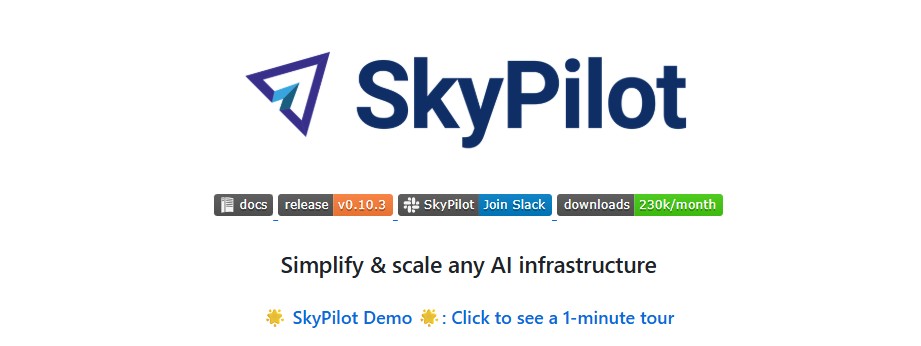As artificial intelligence continues to reshape industries, managing and scaling AI workloads has become increasingly complex. Enterprises and research teams often struggle to balance cost, performance and scalability across different infrastructures like Kubernetes, cloud platforms and on-premises clusters. SkyPilot solves this challenge by offering a unified, infrastructure-agnostic system that simplifies workload orchestration and optimizes resource usage.

Image Source : SkyPilot Github Repo
By abstracting away infrastructure details, it empowers teams to focus on building, training and deploying AI applications instead of worrying about provisioning resources. Let’s dive into how SkyPilot transforms AI workload management and why it’s becoming a must-have tool for modern AI teams.
Why SkyPilot Matters in Today’s AI Landscape ?
Running large-scale AI workloads such as training large language models (LLMs), deploying retrieval-augmented generation (RAG) systems or scaling inference services requires seamless integration across multiple compute environments. Without the right platform, teams face challenges like vendor lock-in, underutilized GPUs and rising cloud costs.
SkyPilot addresses these issues with a unified control plane that integrates with Kubernetes, 16+ cloud providers and on-premises clusters. This flexibility ensures organizations can run AI workloads anywhere while maintaining consistency and cost efficiency.
Key Features
1. Unified AI Workload Management
It provides a single interface to launch and monitor AI workloads. Teams can:
- Train models on GPUs, TPUs or CPUs
- Finetune and deploy LLMs like Llama, GPT-OSS, or Qwen
- Automate orchestration for distributed jobs
- Track performance, logs, and progress in real-time
This centralized approach eliminates the need for multiple frameworks and reduces operational overhead.
2. Multi-Cloud and Multi-Cluster Flexibility
It allows teams to seamlessly provision resources across AWS, GCP, Azure, OCI, IBM, Paperspace, RunPod and more. Key benefits include:
- Auto-retry & failover in case of capacity shortages
- Intelligent scheduling to minimize costs and maximize GPU availability
- Spot instance support with preemption recovery for significant savings
This ensures uninterrupted workflows while maximizing resource efficiency.
3. Infrastructure as Code for AI Jobs
SkyPilot treats jobs and environments as code. Users can define resources, setup commands and execution steps in YAML or Python API, making deployments reproducible and portable.
For example, a few lines of YAML can provision GPUs, install dependencies and execute training scripts – all with a single sky launch command.
4. Cost Optimization and Auto-Scaling
Cloud costs remain one of the biggest barriers to AI adoption. SkyPilot optimizes spending by:
- Stopping idle resources automatically
- Leveraging spot instances for 3–6x savings
- Scheduling workloads on the cheapest available infrastructure
- Recovering from preemption without manual intervention
This ensures AI teams can scale efficiently without overspending.
5. Real-World Applications of SkyPilot
SkyPilot is not just a theoretical solution – it powers a wide range of real-world AI use cases:
- LLM Training: Distributed fine-tuning of models like Llama 4 or GPT-OSS
- AI Serving: Running real-time inference with frameworks like vLLM or Ollama
- RAG Applications: Deploying retrieval-augmented generation pipelines with databases like ChromaDB
- Framework Support: Seamless integration with PyTorch, JAX, Ray, and Airflow
This versatility makes SkyPilot suitable for startups, research labs and enterprises alike.
6. Simple Installation and Quick Start
Getting started with SkyPilot is straightforward. A single installation command enables multi-cloud and Kubernetes support:
pip install -U "skypilot[kubernetes,aws,gcp,azure,oci,lambda,runpod,fluidstack,paperspace,ibm]"
Nightly builds are also available for teams looking to experiment with the latest features.
7. Advanced Features for Enterprise AI Teams
SkyPilot offers robust features designed for scaling complex workloads:
- Slurm-like orchestration with cloud-native reliability
- Local development on Kubernetes with SSH access to pods
- Gang scheduling & multi-cluster scaling for distributed training
- Unified control plane for both AI and infrastructure teams
These capabilities bridge the gap between researchers and infrastructure engineers, streamlining collaboration.
Why Choose SkyPilot?
Organizations adopting SkyPilot benefit from:
- Reduced complexity in managing multi-cloud AI infrastructure
- Increased scalability for training and serving AI models
- Automated cost savings through intelligent resource allocation
- Full portability and flexibility for all types of AI workloads
By eliminating infrastructure bottlenecks, SkyPilot allows teams to accelerate model development and deployment cycles ultimately giving them a competitive edge.
Conclusion
As AI workloads grow in scale and complexity, traditional infrastructure management is no longer enough. SkyPilot provides a unified, cost-efficient and portable solution that simplifies orchestration across clouds, clusters and on-prem environments. Whether it’s training LLMs, serving real-time inference or building RAG pipelines, SkyPilot ensures seamless execution with maximum flexibility.
For AI teams looking to stay ahead in the fast-moving AI era, SkyPilot is more than just a tool, it’s a strategic advantage.
Related Reads
- Motia: The Unified Backend Framework That Eliminates Runtime Fragmentation
- MLOps-Basics: A Step-by-Step Guide to Mastering Machine Learning Operations
- LLaMA-Factory: Simplifying Fine-Tuning for 100+ Large Language and Vision Models
- RAGFlow: Revolutionizing AI with Retrieval-Augmented Generation
- GraphRAG: The Future of Retrieval-Augmented Generation with Knowledge Graphs

3 thoughts on “SkyPilot: Simplifying AI Workload Management Across Any Infrastructure”